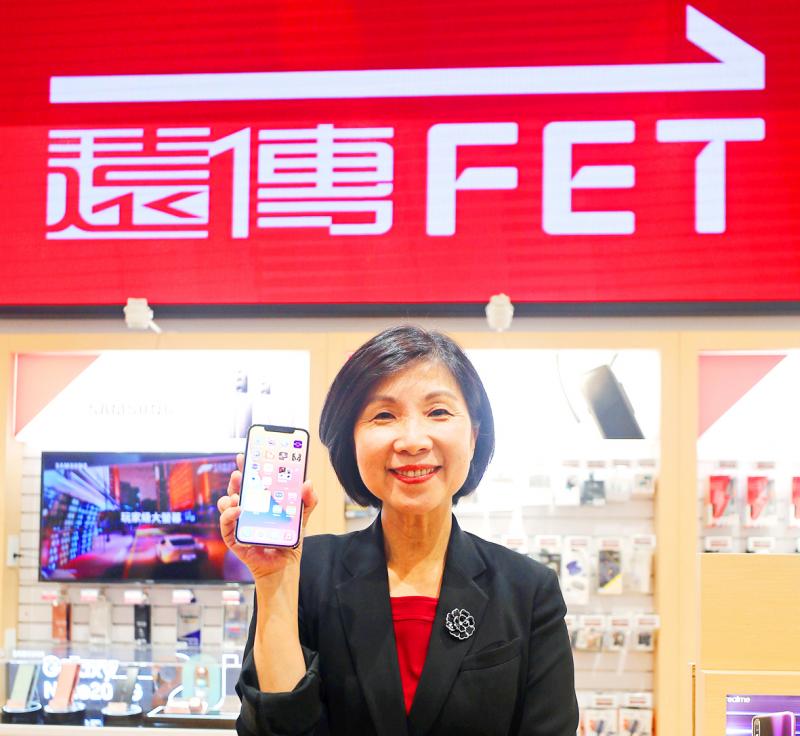Far EasTone Telecommunications Co (遠傳電信) yesterday said it has signed an agreement with Asia Pacific Telecom Co (亞太電信) to extend their collaboration in 5G spectrum sharing to 4G networks.
Based on the agreement, Far EasTone would share 25 megahertz of its 700 megahertz (MHz) band with Asia Pacific Telecom for 20 years.
The spectrum is used by telecoms to offer 4G services.

Photo: CNA
The two firms are to share costs for the spectrum, as well as network deployment expenses.
The transaction is subject to the approval of the National Communications Commission (NCC), Far EasTone said.
The NCC has rules that allow 5G spectrum sharing, but ban 4G spectrum sharing.
The partnership came after Far EasTone on Sept. 4 announced that it planned to pay up to NT$5 billion (US$173.17 million) to acquire an 11.58 percent stake in Asia Pacific Telecom through a private placement as part of a plan to share 5G spectrum on the 3.5 gigahertz (GHz) band.
“We are looking to share that spectrum in addition to the 3.5GHz 5G sharing,” Far EasTone president Chee Ching (井琪) told investors at a teleconference.
“That [700MHz spectrum sharing] is very useful and efficient to improve our spectrum performance not only for 4G, but also 5G, for indoor penetration,” Ching said. “This will be a powerful addition to our already premium spectrum for 5G.”
If the NCC bans the sharing of 700MHz spectrum, Far EasTone plans to trade 5MHz of its 2.6GHz band for Asia Pacific Telecom’s 700MHz band, she said.
Commenting on Far EasTone’s progress in converting its 4G subscribers to 5G services, Ching said: “We are ahead of our target.”
More than 300,000 people using 4G services are expected to switch to 5G services before the end of this year, Ching said.
Far EasTone aims to deploy 4,000 5G base stations by the end of the year, she said.
The company hopes to boost its 5G penetration to 20 percent within a year of the launch of 5G services, she said.
Far EasTone said that 5G subscriptions have boosted its average revenue per user (ARPU) and the effect is magnifying following the launch of the 5G-enabled iPhone 12 series.
More than 97 percent of iPhone 12 buyers signed up for a high-rate plan, starting at NT$999, it said.
In the first three quarters, Far EasTone’s net profit was NT$6.47 billion, or earnings per share (EPS) of NT$1.99, beating its forecast of NT$6.15 billion.
That represented about a 1.97 percent decline from net profit of NT$6.6 billion, or EPS of NT$2.03, in the first three quarters of last year.
Revenue was NT$60.9 billion in the first three quarters, down 2.79 percent from NT$62.65 billion in the same period last year.

TARIFF TRADE-OFF: Machinery exports to China dropped after Beijing ended its tariff reductions in June, while potential new tariffs fueled ‘front-loaded’ orders to the US The nation’s machinery exports to the US amounted to US$7.19 billion last year, surpassing the US$6.86 billion to China to become the largest export destination for the local machinery industry, the Taiwan Association of Machinery Industry (TAMI, 台灣機械公會) said in a report on Jan. 10. It came as some manufacturers brought forward or “front-loaded” US-bound shipments as required by customers ahead of potential tariffs imposed by the new US administration, the association said. During his campaign, US president-elect Donald Trump threatened tariffs of as high as 60 percent on Chinese goods and 10 percent to 20 percent on imports from other countries.

Taiwanese manufacturers have a chance to play a key role in the humanoid robot supply chain, Tongtai Machine and Tool Co (東台精機) chairman Yen Jui-hsiung (嚴瑞雄) said yesterday. That is because Taiwanese companies are capable of making key parts needed for humanoid robots to move, such as harmonic drives and planetary gearboxes, Yen said. This ability to produce these key elements could help Taiwanese manufacturers “become part of the US supply chain,” he added. Yen made the remarks a day after Nvidia Corp cofounder and chief executive officer Jensen Huang (黃仁勳) said his company and Taiwan Semiconductor Manufacturing Co (TSMC, 台積電) are jointly

United Microelectronics Corp (UMC, 聯電) expects its addressable market to grow by a low single-digit percentage this year, lower than the overall foundry industry’s 15 percent expansion and the global semiconductor industry’s 10 percent growth, the contract chipmaker said yesterday after reporting the worst profit in four-and-a-half years in the fourth quarter of last year. Growth would be fueled by demand for artificial intelligence (AI) servers, a moderate recovery in consumer electronics and an increase in semiconductor content, UMC said. “UMC’s goal is to outgrow our addressable market while maintaining our structural profitability,” UMC copresident Jason Wang (王石) told an online earnings

MARKET SHIFTS: Exports to the US soared more than 120 percent to almost one quarter, while ASEAN has steadily increased to 18.5 percent on rising tech sales The proportion of Taiwan’s exports directed to China, including Hong Kong, declined by more than 12 percentage points last year compared with its peak in 2020, the Ministry of Finance said on Thursday last week. The decrease reflects the ongoing restructuring of global supply chains, driven by escalating trade tensions between Beijing and Washington. Data compiled by the ministry showed China and Hong Kong accounted for 31.7 percent of Taiwan’s total outbound sales last year, a drop of 12.2 percentage points from a high of 43.9 percent in 2020. In addition to increasing trade conflicts between China and the US, the ministry said